What’s the Best LED Downlight for Commercial and Architectural Projects?
Looking for Reliable LED Downlight Suppliers from China?
REQUEST A QUOTE FOR MORE DETAILS
LED Downlights Manufacturer & Supplier from China | OEM, Custom Options Available
Introduction:
As a seasoned LED lighting engineer and manufacturer, I’ve spent years designing and installing LED downlights in all kinds of commercial projects. In this ultimate guide, I’ll share my firsthand insights on selecting the right LED downlights, customizing them to project needs, and understanding the key components that make up a quality fixture. My goal is to talk you through the technical details in a conversational, first-person tone – from one lighting professional to another – so you can make informed decisions with confidence.
Why trust me? Because I’ve been in the trenches: from retrofitting old offices with anti-glare downlights to crafting custom fixtures for upscale hotels. I’ll explain not just what specifications to look for, but why they matter in real-world applications. So let’s dive in.

Understanding LED Downlights and Their Benefits
LED downlights (also known as recessed ceiling lights or can lights) are those sleek, circular fixtures you often see embedded flush with the ceiling. Unlike bulky hanging lights, downlights provide a clean, modern look – the fixture itself is mostly hidden, directing light downward. In my experience, commercial LED downlights have become the go-to choice for offices, retail stores, hotels, and even industrial corridors, due to a combination of benefits:
Energy Efficiency: LED technology has dramatically cut power consumption. Replacing old fluorescent or halogen downlights with LEDs can halve the energy use for the same light output. For example, one 19W LED downlight we used in a retail project produced about 1140 lumens (equivalent to a pair of 18W CFLs), and modern designs achieve even higher efficacy. This means big energy savings for large facilities.
Long Lifespan: Quality LED downlights are built to last. Many are rated for 50,000 hours or more of operation. To put that in perspective, in an office running lights 10 hours a day, that’s around 13 years of life. In practice, I’ve seen well-made downlights easily outlast their warranties – which saves maintenance crews a lot of bulb-changing headaches.
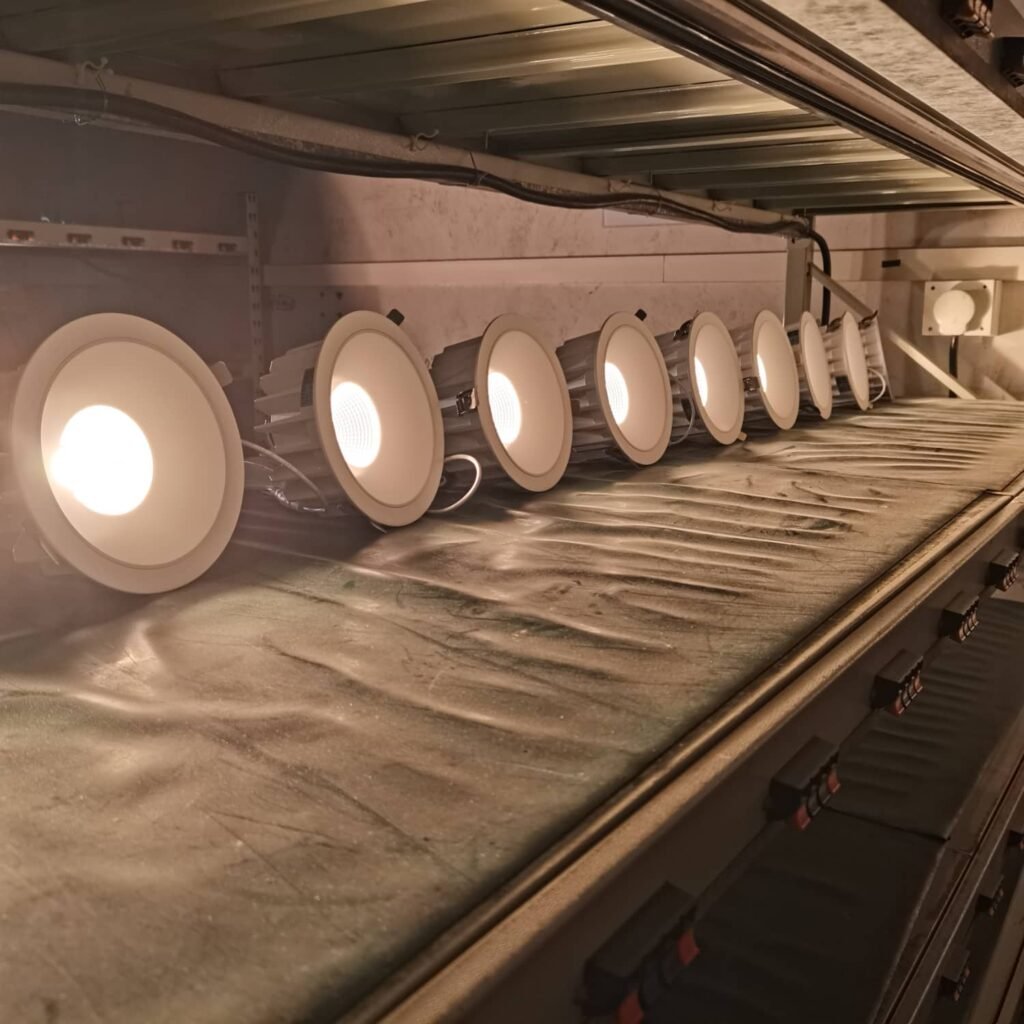
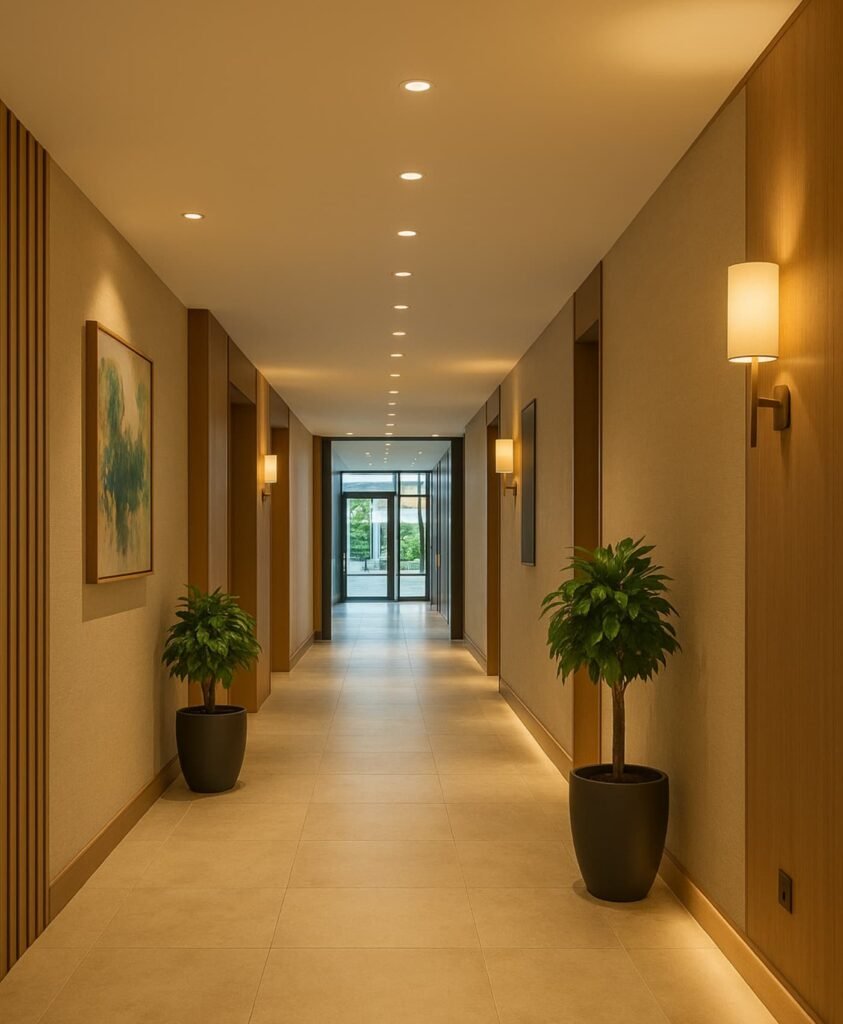
Better Light Quality: With LEDs, we can fine-tune light characteristics like color temperature and color rendering to suit the space. I’ll discuss this more later, but it’s a huge advantage. In high-end retail, for instance, we use downlights with high CRI (90+) to make merchandise colors pop and appear true-to-life, something earlier tech struggled with.
Sleek Aesthetics: Since they are recessed, downlights keep the ceiling line clean. Architects love this minimalist look. And today, we have options like trimless downlights or various trim finishes, which allow these fixtures to either disappear into the architecture or complement it. In one hotel lobby project, we custom-painted downlight trims in a bronze finish to match the interior design – the result was subtle and very elegant.
Directional Lighting & Control: Downlights create a focused downward beam, which is great for task lighting or creating spotlight effects. Need to highlight a product display or a reception desk? LED downlights let you do that with various beam angle choices. They are also typically easy to integrate with dimmers and lighting control systems, giving facility managers flexibility to adjust ambiance and save energy.
In short, LED downlights offer a winning combination of efficiency, longevity, and lighting quality in a low-profile package. But to get the most out of them, you need to choose the right ones for your needs. Let’s go step by step through the selection process.
Key Factors When Selecting LED Downlights
Selecting an LED downlight for a commercial project isn’t just about picking a random fixture off a catalog. I always walk through a checklist of specifications and considerations with my clients. Here are the key factors and what I pay attention to, based on practical experience:
Brightness (Lumens) vs. Wattage: How to Choose Efficient LED Downlights
One of the first questions any lighting contractor or facility manager should ask is:
“How much light do we actually need in this space?”
When planning a lighting project, one of the first things I consider is how much light the space needs — measured in lumens, not watts. Lumens represent total light output, and LED downlights today come in a range from 800 to 3000+ lumens to suit different ceiling heights and functions. For example, a 4-inch 800-lumen downlight works well in a small office with a 2.5m ceiling, but a 4-meter hotel lobby may need 2000 lumens or more per fixture. I always advise clients not to focus on wattage alone. With LEDs, what really matters is efficacy — how many lumens you get per watt. A few years ago, 60 lm/W was common. Now, many quality commercial models reach 100+ lm/W, meaning the same brightness with half the energy.
| Application Type | Ceiling Height | Recommended Lumens per Downlight |
|---|---|---|
| Office (general) | 2.5 – 3 meters | 800 – 1200 lumens |
| Hotel Corridor | 2.7 – 3 meters | 1000 – 1500 lumens |
| Retail Store | 3 – 4 meters | 1500 – 2000 lumens |
| Hotel Lobby / Showroom | 4+ meters | 2000 – 3000+ lumens |
To select the right brightness, I work backward from the target lux level (light on the surface). An office desk needs 300–500 lux; corridors, about 100–200 lux. A quick rule I use: one 600–800 lm downlight per 10 m² for soft general lighting. For precise planning, a lighting simulation tool like Dialux is always best.

How LED Downlights Affect Mood and Visual Impact
🔆 Color Temperature (CCT) and Ambiance
One major advantage of LED downlights is control over color temperature, measured in Kelvin (K). This isn’t the color of the fixture itself — it’s the color of the light emitted, and it plays a key role in setting the mood and function of a space.
| CCT Range | Description | Common Applications |
|---|---|---|
| 2700K – 3000K | Warm white – soft, yellowish tone | Hotels, lounges, restaurants, homes |
| 3500K – 4000K | Neutral white – clean, balanced light | Offices, shops, corridors, commercial areas |
| 5000K – 6500K | Cool white/daylight – bluish, clinical feel | Labs, hospitals, manufacturing, task areas |
For example, in a boutique hotel lobby, we used 3000K downlights to match the warm-toned interiors, creating a relaxing and premium feel. In contrast, we’ve upgraded many offices to 4000K to support focus and productivity without the coldness of daylight tones.
Some LED downlights today offer CCT-selectable options, allowing you to adjust the temperature via a switch or control system. I often recommend these for multi-use spaces like conference halls or event venues — you can shift from warm lighting for dinners to cool white for business meetings at the touch of a button.
📷 Suggested image: Kelvin color scale + real space comparison photos
🎨 Color Rendering Index (CRI) and Light Quality
Beyond temperature, the quality of light is just as important — and that’s where CRI (Color Rendering Index) comes in. CRI measures how accurately colors appear under a given light, compared to natural daylight (100 being perfect). A higher CRI means more vivid, true-to-life color.
| CRI Rating | Color Accuracy | Where to Use |
|---|---|---|
| 80–85 | Good (standard quality) | Offices, warehouses, general commercial use |
| 90+ | Excellent (high fidelity) | Retail stores, galleries, showrooms, restaurants |
In one retail chain project, we switched from CRI 80 to CRI 95 LED downlights for the clothing displays. The improvement was immediate — colors popped, fabrics looked richer, and customer engagement increased. The client eventually standardized all stores to 90+ CRI lighting.
This isn’t just a spec on a datasheet — it affects how people perceive your space, your brand, and even your product quality. For visual-critical environments like fashion, fine dining, art, or premium offices, I always recommend 90+ CRI fixtures. For less color-sensitive areas like storage rooms or back offices, CRI 80+ is typically sufficient.
📷 Suggested image: side-by-side CRI 80 vs. CRI 90+ display, fabric or food visual test
Optical Design and Visual Comfort in LED Downlights
🎯 Beam Angle and Light Distribution
Beam angle determines how narrow or wide a downlight spreads its light — a critical but often overlooked aspect. A narrow beam (15–30°) creates a focused cone, ideal for highlighting displays, artwork, or architectural features. A wide beam (60–120°) delivers broader coverage, perfect for general illumination in open spaces.
Here’s how I approach beam angle selection:
Accent Lighting: For retail shelves, reception desks, or museum pieces, I use 15°, 24°, or 36° beams to spotlight specific areas without spill. In one museum project, 24° optics lit sculptures cleanly while keeping floors dim.
General Lighting: In offices or hotel lobbies, 60°+ beams ensure even coverage with overlapping light — avoiding bright spots and shadows. This helps prevent the “cave effect” where walls appear darker than floors.
Ceiling Height Matters: The higher the ceiling, the more the beam spreads before reaching surfaces. For tall spaces like churches, we use 30–40° beams to deliver a wide spread at floor level.
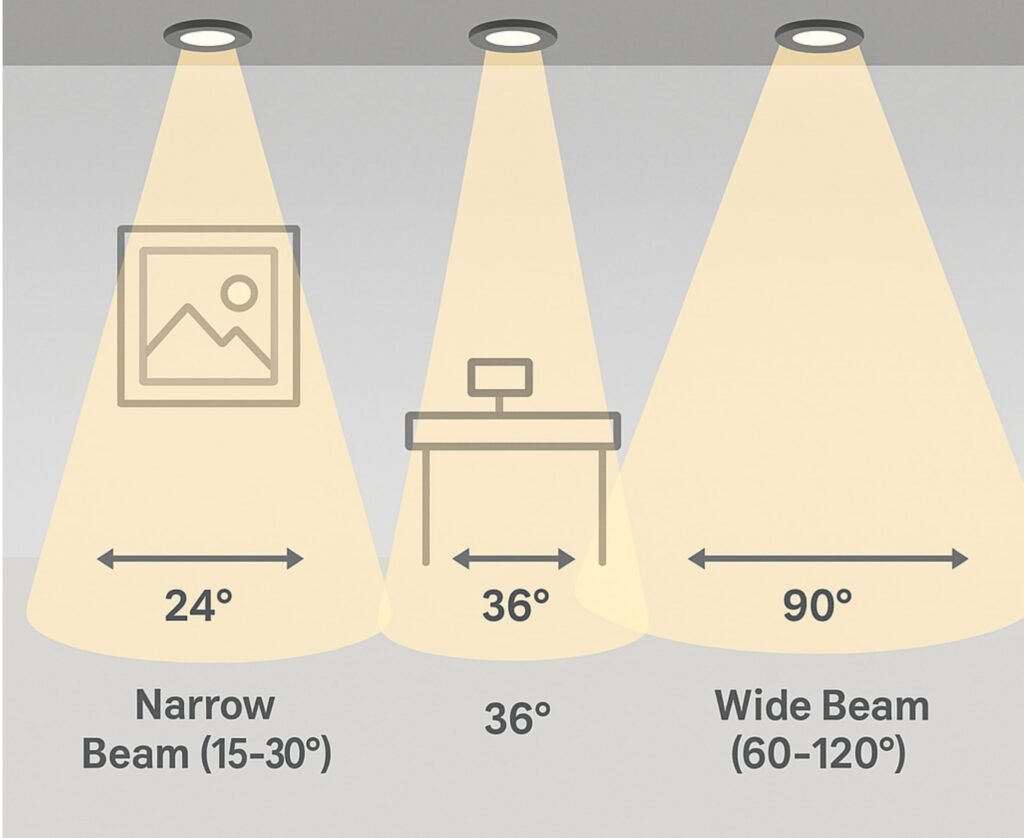
Many modern LED downlights offer interchangeable lenses or reflectors, making it easy to adjust beam angles on-site. I remember one project where we needed more focus in certain areas post-installation — swapping in a narrower lens solved it instantly, without changing the fixtures.
📐 Tip: Always review photometric diagrams or request lighting simulations for large spaces. Beam angle impacts fixture count, spacing, and visual balance.
📷 Suggested visual: Beam angle comparison chart + ceiling height effect diagram
👁️ Glare Control (UGR) and Eye Comfort
Glare is one of the most common complaints in poorly lit commercial spaces. Whether it’s from poorly placed downlights or overly bright sources, glare causes eye strain, discomfort, and lower productivity. That’s why anti-glare design is now essential in professional lighting specs.
Key features I look for:
Deep-Recessed LED Source: Downlights with the light source set deeper inside reduce direct line-of-sight to the LED. These often use baffles or matte reflectors to block harsh angles. A sharp cut-off angle (e.g. >30°) ensures you don’t see the light source unless standing directly below. I’ve installed deep-recessed “darklight” downlights in offices — you get soft light on the desk but no glare in your eyes.
Honeycomb Lenses & Diffusers: Accessories like honeycomb louvers or prismatic covers cut glare further. They can slightly reduce output, but for high-end retail or hospitality spaces, the comfort tradeoff is worth it.
Unified Glare Rating (UGR): This is the industry’s standard for measuring glare. For office or educational lighting, UGR < 19 is the target. In one open-plan office we retrofitted with UGR 16 downlights, staff immediately reported better screen visibility and fewer glare complaints.
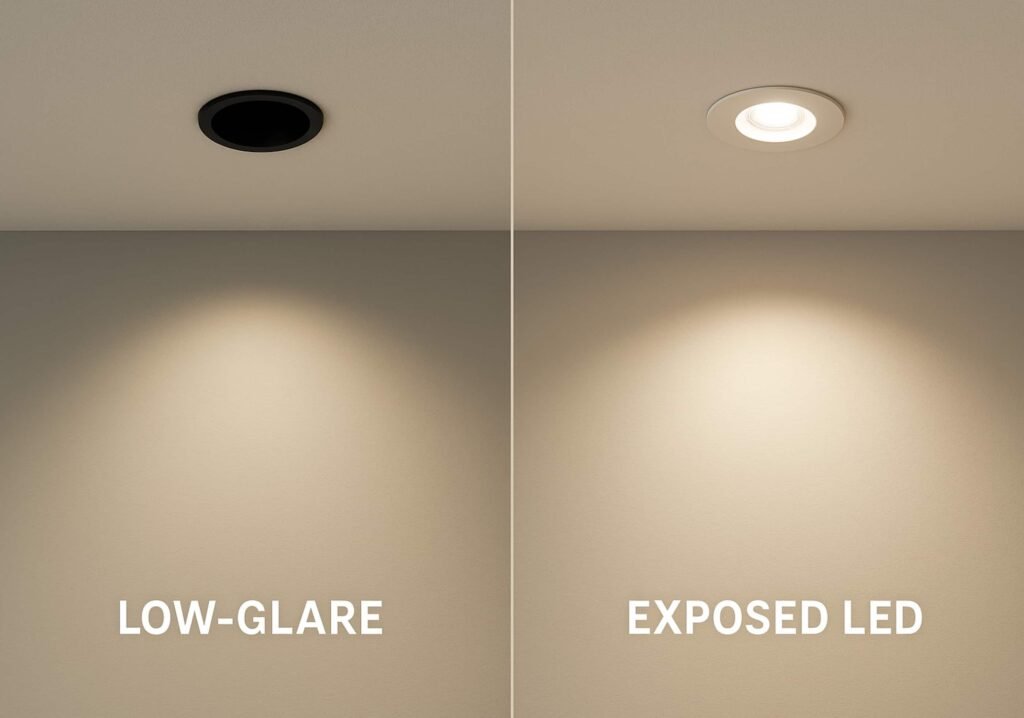
| UGR Rating | Visual Comfort | Typical Use Case |
|---|---|---|
| >22 | High glare (uncomfortable) | Old halogen grid lighting |
| ≤ 19 | Comfortable for offices | Modern LED downlights, open workplaces |
| ≤ 16 | Premium visual comfort | Design studios, labs, luxury interiors |
If comfort matters — and it usually does — look for terms like “low UGR,” “cut-off angle,” “darklight,” or “anti-glare reflector.” These features make a real difference in spaces where people work, shop, or relax.
📷 Suggested visual: UGR scale + real example of low-glare vs. exposed-LED downlight
Customization Options for LED Downlights
One of the advantages of working directly with an LED manufacturer (like us) or a flexible supplier is the ability to customize downlights to fit a project’s unique needs. Over the years, I’ve learned that a one-size-fits-all approach doesn’t always work in commercial lighting – a retail store has different priorities than a hospital, and an upscale hotel has a different aesthetic than a tech office. Here are some ways LED downlights can be customized or specified to make them just right:
Design and Aesthetics Customization
Trim Style and Finish Options
The trim, or outer ring of a downlight, can be customized to match the ceiling or elevate the overall interior design. The most common option is a round, white trim — clean and minimal. But we’ve delivered:
Square trims for contemporary interiors
Matte black or silver trims for a modern industrial look
Custom RAL colors on request
In a luxury retail project, the designer requested downlight trims in anodized gold to complement ceiling accents — a small detail, but with dozens of fixtures, the impact was striking and cohesive.
Trimless and Regressed Options
For a seamless, minimalist ceiling, trimless downlights are a popular choice. These are installed flush with the plaster ceiling, leaving only a clean opening with no visible flange. We’ve supplied trimless kits for art galleries and modern homes where the light source appears to float invisibly.
Another aesthetic variant is the regressed trim, where the light source is set deeper within a black or dark interior ring. This not only reduces glare but also makes the fixture less visually intrusive — ideal for luxury hospitality or residential applications.
Adjustable vs. Fixed Fixtures
Depending on the use case, you can choose between:
Fixed downlights, for clean, uniform lighting
Adjustable or gimbal downlights, which can tilt and rotate to direct light
Adjustable models are ideal for retail displays, artwork, or flexible commercial layouts. For example, in a fashion store, we installed adjustable downlights that could be aimed at mannequins and changed seasonally — without relocating any fixtures.
Aperture Size and Retrofit Flexibility
LED downlights come in multiple aperture sizes — commonly 2″, 4″, 6″, and 8″. While smaller apertures provide a sleek, minimalist look, larger sizes offer more output and better coverage for high-ceiling or open areas.
In retrofit scenarios, size plays a crucial role. For example, we upgraded an old commercial space with 8-inch CFL can lights. Instead of reconstructing the ceiling, we supplied custom 8-inch LED modules to fit the existing cut-outs — saving both time and cost.
Final Tip: Match Form to Function
When choosing downlight design elements, don’t just consider appearance — think about the application, space usage, and maintenance. Aesthetic customization is more than skin deep; when done right, it supports the lighting intent and elevates the overall environment.
Optical and Performance Customization for Project-Specific Needs
Beyond exterior design, professional LED downlights can be fine-tuned for performance, precision, and visual experience. At Lowcarbon, we regularly customize optics, LEDs, drivers, and control features to meet the unique demands of lighting designers, architects, and system integrators.
Beam Angles and Optical Control
Many of our downlights come with interchangeable lenses or reflectors, allowing tailored light distribution. This is crucial in projects like galleries, retail, or museums, where the beam must be highly controlled.
For a gallery project, we custom-tooled a 15° reflector to spotlight artwork — tighter than the standard 24° model.
In other cases, we’ve added diffusion lenses to widen beam angles for softer, ambient coverage.
Whether narrowing focus or softening the throw, we adjust optics to put the light exactly where it’s needed.
CRI and LED Chip Selection
Some clients have precise color quality requirements — for example, CRI 90+ with strong R9 values for red accuracy in artwork, fashion, or food displays.
We offer LED module customization using Nichia, Citizen, Bridgelux, or Cree chips.
For art galleries and luxury retail, we’ve supplied special LED engines known for high color fidelity.
If a project calls for warm-dimming, we can specify modules that mimic incandescent dimming (color temperature lowers as brightness dims), perfect for hospitality or residential spaces.
Color Temperature Flexibility
Different areas of a building often require different CCTs (Correlated Color Temperatures):
2700K in hotel guest rooms for warmth and comfort
3500K or 4000K in conference spaces for a brighter, neutral feel
We supply fixed-CCT fixtures or CCT-selectable downlights (e.g. 3000K/4000K/5000K in one unit via switch). This flexibility is especially useful during early design stages when final ambiance decisions are still evolving.
📦 Tip: CCT-tunable models are ideal for clients who want to test different lighting scenes on-site before locking in a final setup.
Dimming, Intensity, and Firmware Customization
For high-end venues like theaters, private villas, or media studios, we’ve handled special requests involving:
Custom dimming curves (e.g. slow fade-to-black in auditoriums)
High PWM frequency drivers for flicker-free performance on camera
DMX or DALI control compatibility for system integration
In one project, we even worked with the driver manufacturer to modify firmware for a smoother dimming transition — a rare ask, but possible with the right engineering collaboration.
Final Note: Customization = Control
Optical and performance customization allows lighting professionals to deliver the exact effect they envision — whether that’s subtle mood lighting in a boutique hotel or precision-aimed beams in a gallery.
At Lowcarbon, we don’t just supply LED downlights — we engineer them to fit your project.
Key Components of an LED Downlight (and Why They Matter)
To truly appreciate what makes a good LED downlight (and to communicate with suppliers effectively), it helps to know the key components that go into one. I often break this down when educating customers or new engineers on our team. A downlight isn’t just an LED bulb in a can – it’s a system of parts working together. Let’s dissect a typical LED downlight and highlight what to look for in each component:
1. The LED Light Source
🔘 COB vs. SMD: What’s the Difference?
COB LEDs are the most common choice in downlights where a single, focused beam is needed. They offer a halogen-like point source, pair well with reflectors, and produce clean, shadow-free light. I often prefer COB downlights for applications requiring precise beam control and architectural aesthetics.
SMD arrays, on the other hand, use many small LEDs spaced across a board. These are typically used with a diffuser to create soft, wide, and uniform illumination — ideal for ambient lighting but not as intense at the center.
Choosing the right LED type depends on the lighting effect and application: sharp focus vs. soft wash, high intensity vs. wide spread.
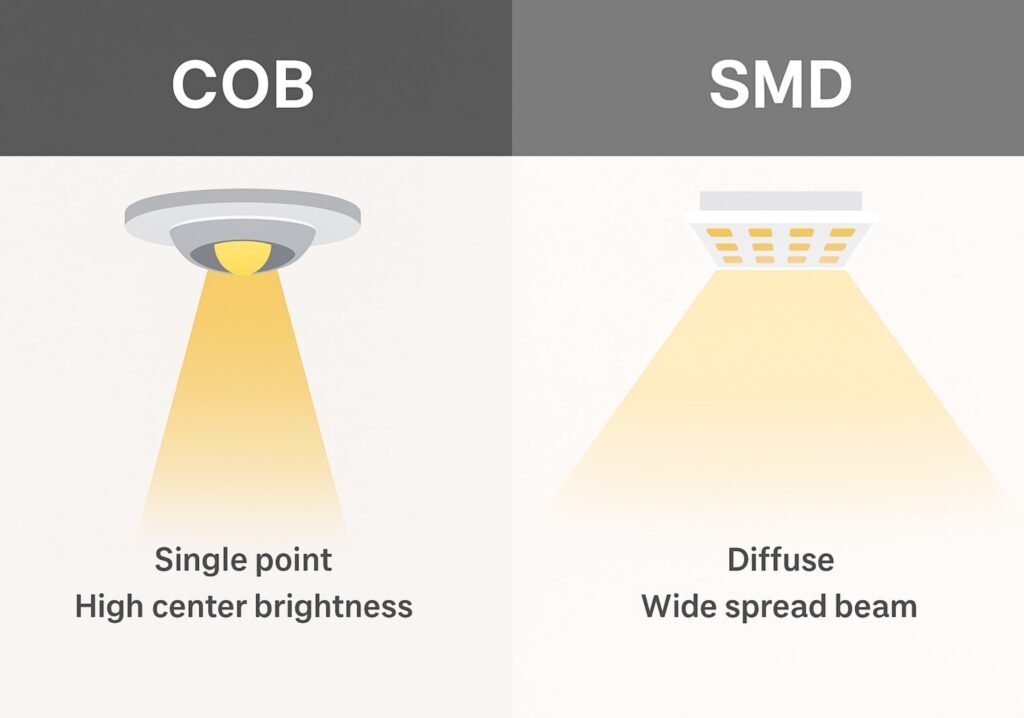
Brand Matters: LED Quality and Binning
High-performance downlights often specify the LED brand — such as Cree, Nichia, Samsung, or Bridgelux — which can signal better reliability, lifespan, and color rendering.
Just as important is binning consistency. In large-scale installations, mismatched LED bins can cause visible color shifts between fixtures — half the lights may look slightly yellowish while others appear cool white. We always ensure all LEDs for a project come from the same bin group, often rated at <3 SDCM (Standard Deviation of Color Matching) to maintain visual uniformity. If your client is picky about color consistency — this detail matters.
♻️ Upgradeability (Optional, but Interesting)
While rare, some downlight designs feature modular LED light engines that can be replaced or upgraded without changing the entire fixture. I once worked on a project considering this for long-term sustainability: future-proofing with removable modules in case LED technology advanced. In the end, they didn’t pursue it, but the concept is valuable in circular design and eco-conscious building strategies.
2. The LED Driver (Power Supply)
The driver is more than just a power supply — it’s the brain and backbone of any LED downlight. It converts mains AC voltage into a safe, constant current for the LEDs, and also handles features like dimming, protection, and flicker control.
⚙️ Quality, Protections & Certifications
A good driver determines the reliability and longevity of the entire fixture. Internally, it contains sensitive components (like capacitors) that wear over time — so build quality matters.
Look for surge protection, over-temperature protection, and official certifications like UL, TUV, CE, or ENEC.
In my experience, downlights using branded drivers (such as Osram, Tridonic, Lifud) consistently outperform generic options.
I often inspect the driver case — if it’s unbranded and lacks markings, that’s a red flag.
For large projects, I always push for name-brand drivers. They may cost more, but they save clients the headache of early failures.
🔄 Output & Compatibility
Every LED module has a specific voltage and current requirement, and the driver must match it exactly. While pre-configured fixtures handle this for you, custom retrofits require careful pairing.
Example: Swapping an old CFL housing for an LED module? You’ll need to select a driver with the correct output specs.
Also consider dimming protocols — TRIAC, 0–10V, DALI, or DMX drivers each behave differently. Using the wrong type leads to flickering, buzzing, or non-response.
We always verify dimming compatibility upfront, especially in projects that integrate building automation or smart lighting systems.
📉 Flicker Performance & Electrical Stability
This is where many low-end drivers fall short. Poor-quality drivers can output pulsed or unstable current, causing flicker. Even if it’s invisible to the eye, it may:
Show up on cameras and video recordings
Cause eye strain or fatigue in office environments
Fail sensitive applications like film sets, control rooms, or classrooms
Our benchmark: Drivers with <5% ripple and high-frequency PWM or pure DC output. For office installations, I personally never ship flickery drivers — we’ve seen how much better user comfort and satisfaction is when flicker is minimized.
📏 Form Factor: Integral vs. Remote Drivers
Driver placement impacts installation flexibility and thermal performance:
Integral drivers (built into the fixture) are compact and easier to install — one piece, one connection.
Remote drivers (separate boxes) allow for larger heatsinks, easier maintenance, and better airflow — ideal for high-performance or long-life applications.
In tight ceiling spaces, we choose compact or linear-form drivers. Where space allows, we recommend external drivers for extended lifespan and heat control. It’s all about balancing design constraints with performance.
3. Heat Sink & Thermal Management
Thermal management is crucial to the performance, lifespan, and safety of any LED downlight. While LEDs are more efficient than halogens or CFLs, they still generate internal heat — and if that heat isn’t managed properly, the LED’s brightness, color stability, and life expectancy will degrade rapidly.
The heat sink is the primary component responsible for pulling heat away from the LED chip and safely dispersing it into the surrounding air.
🛠️ Material & Cooling Design
The heat sink is typically made from aluminum due to its light weight and excellent thermal conductivity. Most commercial downlights use either:
A thick cast aluminum body, or
A finned heat sink, which increases surface area for air cooling
Some premium fixtures may incorporate copper or thermal composites, but aluminum remains the industry standard. A few ultra-high-power models use active cooling (mini fans) — but I tend to avoid those. Fans mean moving parts, and moving parts can fail. For commercial spaces, passive cooling (metal only) is far more reliable.
Size = Heat Capacity
There’s a simple rule: bigger heat sink, better cooling.
A 2000-lumen downlight needs significantly more thermal mass than a 500-lumen under-cabinet fixture.
When I evaluate build quality, I check the weight and thickness — a solid, heavier fixture usually means it’s thermally sound.
If the housing is too compact for the output, the LED will run hot, leading to lumen depreciation (gradual dimming) and shortened lifespan.
Built-in Thermal Protection
High-end drivers and LED modules often include thermal regulation features. These systems automatically reduce power if temperatures rise beyond safe limits.
I tested one fixture in a thermal chamber, pushing ambient temperature to 50°C. As expected, the smart driver began throttling the current — preventing overheating without noticeable change in light output. That kind of thermal protection is crucial in:
Hot climates
Ceilings with insulation
Long runtime environments (retail, hospitality)
Installation & IC-Rating
Proper installation is just as important as the heat sink itself. Airflow around the fixture matters. If the downlight is covered by insulation, it must be IC-rated (Insulation Contact).
IC-rated downlights are designed to run cool enough even when surrounded by insulation
Non-IC-rated fixtures need space or insulation caps to prevent heat buildup
Whenever we work on a project with insulated ceilings, I always confirm: either we use IC-rated fixtures, or we specify spacing requirements for safe installation. Ignoring this can lead to overheating, lumen loss — or worse, a fire hazard.
4. Optics — Reflector and Lens
The optics of a downlight — including the reflector, lens, diffuser, and accessories — play a vital role in shaping how the light is distributed, how it feels in the space, and how much visual comfort it offers. While the LED chip produces the light, the optics define its character.
Reflector: The Core of Beam Control
Most commercial-grade downlights use a specular or semi-specular reflector, often visible as the inner cone when you look up into the fixture. The reflector’s shape and surface finish directly affect the beam pattern, efficiency, and glare level.
Parabolic or ellipsoidal shapes control beam spread and focus.
Deep reflectors with sharp cut-off angles help reduce glare by shielding the LED from direct view.
Baffles or ridges inside the reflector reduce internal reflections and enhance comfort.
Modular reflectors are often swappable — we’ve adjusted reflector depth or finish post-installation to tweak the beam.
In one gallery project, we used deep parabolic reflectors to create precise 24° beams with minimal glare, even when artworks were hung close to eye level. You’ll rarely see “reflector quality” listed in specs, but terms like “faceted high-efficiency reflector” or available beam photometrics are strong indicators of good design.
Lens & Diffuser: Softening and Spreading the Light
Some downlights come with a front lens or diffuser, while others — especially open COB models — leave the reflector exposed.
Clear lenses maintain maximum output and focus.
Frosted or opal diffusers soften the light, widen the beam, and reduce hot spots.
Prismatic lenses spread light evenly across the surface.
In office spaces, I often recommend a light diffusion layer to eliminate visible LED dots or beam artifacts — it creates a smoother ceiling effect and more even workplane illumination. The trade-off is a slight drop in efficiency, but user comfort often justifies it.
Adjustable and Specialty Optics
For dynamic or premium retail spaces, adjustable optics are an excellent feature:
Zoomable downlights allow manual beam adjustment (e.g. from 15° to 45°) by twisting the lens — perfect for museums or high-end stores where layouts change seasonally.
We installed these in a flagship fashion store where the client frequently updates window displays — no need to replace fixtures, just tune the beam on-site.
These options are less common, but available for projects where lighting flexibility is key.
Glare Accessories and Add-ons
Beyond the core optic, you can often enhance glare control with optional accessories:
Honeycomb louvres cut off angled light and reduce direct glare — ideal when fixtures are above seating areas.
Secondary baffles add another layer of shielding, often with a matte black finish to hide the light source.
These accessories are especially useful in hospitality, offices, and retail, where the downlight may be visible in the user’s line of sight.
That said, the best approach is starting with a well-designed optical system that reduces the need for add-ons.
5. Housing and Mounting Hardware
While most of the attention goes to light quality and output, the housing and mounting system of a downlight plays a vital role in its durability, installability, and code compliance. A well-engineered fixture body ensures long-term reliability and makes the installation process smooth — a key consideration for both procurement and field teams.
Housing Materials: Metal vs. Plastic
Most quality downlights use a cast or die-cast aluminum housing, often shared with the heat sink for better thermal conductivity. For exposed parts like the trim, you may see:
Aluminum trims for premium finishes and durability
Painted steel trims for high-traffic or institutional environments
Plastic trims (more common in economy models) — but prone to yellowing or wear
In one public library project, the client specifically requested metal trims to avoid discoloration from frequent handling. We supplied brushed aluminum units that held up well under public use and could be refinished if needed — a good reminder that housing isn’t just structural, it’s visual and tactile too.
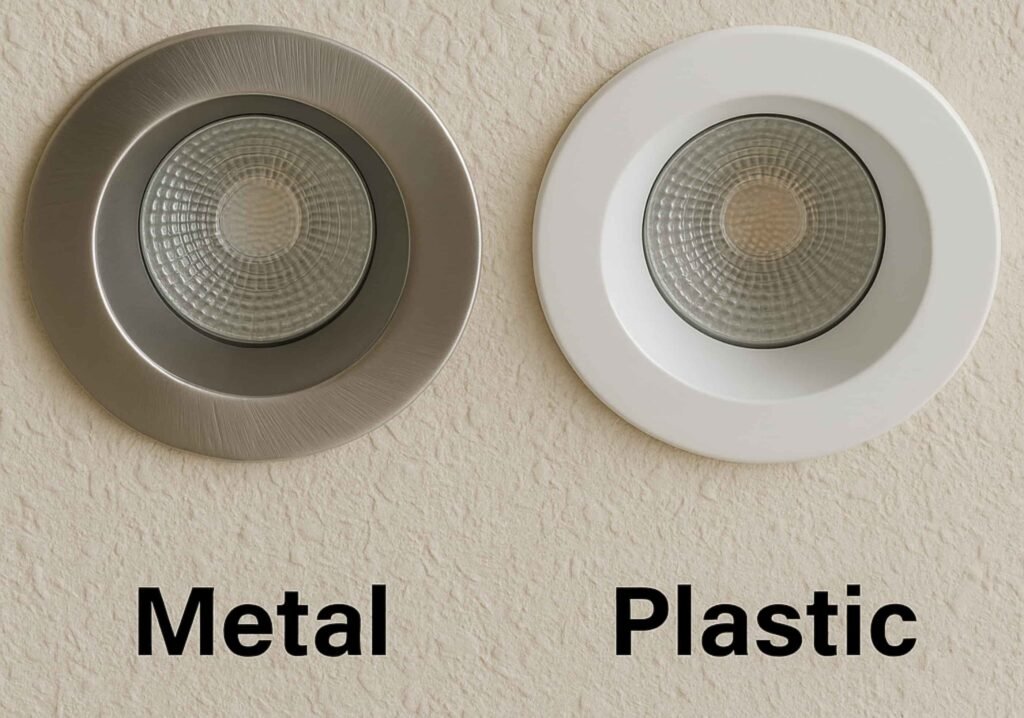
Mounting Types: Recessed, Surface, or Modular
Modern LED downlights come with various mounting styles depending on the ceiling type:
| Ceiling Condition | Recommended Mount Type |
|---|---|
| Drywall ceiling | Recessed with spring clips (standard) |
| T-bar grid ceiling | Panel-compatible LED modules |
| Concrete or solid ceiling | Surface-mounted or shallow recessed housings |
| Retrofit, no ceiling access | Slim-profile surface mount with junction box |
Traditional recessed lights often had a separate housing or “can”, but many modern designs are all-in-one units — simply cut, connect, and clip. For shallow ceilings, we’ve also used low-profile modules with remote drivers to reduce depth.
Installation Features That Save Time
Small hardware details can make a huge difference on the jobsite. Electricians appreciate fixtures that are:
Supplied with quick-connect wiring boxes or push-in terminals
IC-rated, so no separate insulation cap is needed
Pre-wired or come with ample knockouts for daisy-chaining
At Lowcarbon, we actively gather feedback from installers, and based on that, we’ve added features like tool-less connectors, strong spring clips, and clear installation guides with our commercial downlights.
👉 Tip: If you’re sourcing for large projects, always ask how the fixtures are packaged and whether installation accessories (clips, junction boxes, guides) are included.
Adjustability and Aiming Mechanisms
For gimbal or adjustable downlights, the housing includes a pivot mechanism — critical in retail, museum, or hospitality projects where beam aiming is needed.
Key specs to check:
Tilt range (e.g. 30°)
Rotation range (often up to 360°)
Tool-less adjustments and whether the fixture holds its position securely
We installed a series of adjustable downlights in a museum where curators needed to re-aim the lights frequently. The project succeeded because the smooth, lockable gimbals allowed tool-free aiming that stayed fixed even after multiple adjustments.
Airtight & Fire-Rated Options
Certain ceiling types or regional building codes require airtight or fire-rated housings:
Airtight-rated downlights reduce energy loss by preventing airflow into attic spaces.
Fire-rated models feature intumescent barriers that expand during a fire, sealing off ceiling penetrations to maintain fire resistance.
We’ve supplied fire-rated LED downlights for multi-residential buildings and hotels, especially in Europe and the UK where these certifications are strictly enforced. Always confirm if the ceiling has fire or acoustic requirements before selecting a fixture.
In essence, the housing and mounting determine how well the engineering on paper translates to a solid, installable product in the field. I’ve seen beautifully specced lighting get rejected by contractors because it was a pain to install. So now I always consider the installer’s perspective when selecting downlights – this makes everyone’s life easier and the project successful.
FAQS
Technical FAQ About Our LED Downlights
We manufacture downlights from 3W up to 40W, with lumen outputs ranging from 300lm to over 3800lm, depending on size and chip efficiency.
For example, our L159-30W model delivers around 3250–3450lm at 3000K with a UGR<19 glare control reflector. That’s more than enough for high ceilings in commercial spaces like shopping centers or hotel lobbies.
Efficiency is a key performance indicator for us.
Depending on the model, we typically achieve:
90–100 lm/W for CRI >90 models
Up to 120–130 lm/W on CRI 80+ variants with standard drivers
Take our L142-10W downlight for example – it reaches ~1000–1100 lumens at only 10W power draw, using a top-tier COB.
Yes. We work with high-reliability chip brands including San’an, Bridgelux, Citizen, and Osram depending on client needs and CRI/CCT requirements.
For high-end retail or gallery projects, we typically use CRI>90 Citizen COBs. For price-sensitive wholesale clients, San’an or Luminus chips offer excellent cost-performance with stable binning.
Absolutely.
For most of our commercial downlights, especially COB models, we maintain <3 SDCM color consistency – which means no visible color shift across fixtures installed side by side.
For large projects, we even reserve same-batch chips in advance to ensure color uniformity across shipments.
Our reflector and lens systems offer multiple beam angles, including:
15° / 24° / 36° – standard for accent or general lighting
55° / 60°+ – used for wide beam coverage
Some models also offer interchangeable reflectors, so you can fine-tune beam angles on site.
If a project requires something unusual, we can customize reflector optics or TIR lenses as well.
We support:
2700K / 3000K / 3500K / 4000K / 5000K / 6000K
Or CCT-switchable designs (typically 3CCT: 3000K–4000K–5000K) via DIP switch
Tunable white and dim-to-warm (1800K–3000K) options are available for larger volume OEM orders.
Our standard commercial range is CRI>80, but CRI>90 is available on request for any model.
Some models like L136/L139 can even be specified with CRI 95+, perfect for retail or galleries.
We also offer high R9 options (R9>50 or R9>80), which enhance red color reproduction for applications like fresh food retail or art lighting.
We offer:
Non-dimmable and dimmable drivers (Triac, 0-10V, DALI, DMX, Zigbee)
Brands include Lifud, Osram, BOKE, Tridonic, or cost-effective in-house drivers with EMC compliance
Flicker-free (IEEE 1789) and deep dimming (1%) available on most models
We also support emergency drivers (1W–3W) or driver with relay signal output for smart building systems.
Booking
Get in Touch with Us
Customized LED Lighting Solutions
Ready to start your project? Our team is here to provide personalized assistance and answer any questions you may have. Whether you need help with a custom design or just want more information, we’re ready to assist you every step of the way.
Send Us a Message
Fill out the form, and we’ll get back to you within 24 hours.
Our Staff Will Call You
Expect a quick response to discuss your needs.
Get a Quote
We’ll provide a tailored solution and competitive pricing for your project.

